REVIEW: Maou: Encounter with the Shadow. Part 3/3.
REVIEW: Maou: Encounter with the Shadow. Part 1/3
REVIEW: Maou: Encounter with the Shadow. Part 2/3
___________________________
This final research will be written through the prism of my personal experience with Tarot. Firsly, because I really wanted to include a personal touch to this part of the essay just to show why Maou’s Tarot was such a lure for me, and also to show the way I see the cards. And secondly... I just can't write it in another way, because Tarot has this very personal vibe for me.
Preface
One warm summer day 11 years ago, I was having a walk with my mum in Moscow. We were enjoying ourselves just strolling down the streets. And then at a small bookstand something caught my eye. This something eventually became one of the fields of major interest for me. It was a Tarot deck.
I don’t know why exactly I asked mum to buy the deck for me, I didn’t even know anything about divination back then. But there was something at that very moment that made me want the cards. I could never understand that sensation fully. But I never regretted getting that deck. (Especially since I was lucky enough to find a fantastic book on Tarot shortly after.)
Anyway, there I was. A 15-year-old with the classical Tarot deck, a Rider-Waite. It seemed like I got my hands on a mystery, and I felt excited. Slowly but surely I tried to learn the language of the cards, listen to the way they speak. It was quite an experience, these 11 years. I haven’t done regular daily readings, but I knew that even if I haven’t touched the cards for a year, there will come a moment when I want to take them out again.
For me Tarot is not a form of divination. It’s more like getting to know yourself in meditation, opening up and seeing the true you, knowing your strong points and weaknesses, the conscious and the subconscious.
There are dozens of ways to lay out the cards according to the question you’re asking them. I will talk about it later but… there is one spread, allegedly one of the most difficult to interpret. I only tried it once and don’t think I will be trying it for myself again without proper preparation. Ironically, this is the spread I’m going to research in this essay.
So now, without further ado, let me start on the final part of my Maou research.
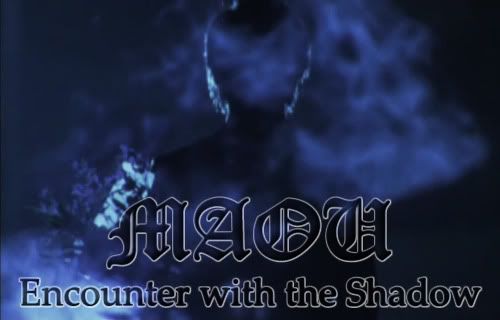
III. Tarot in Maou: Inanna’s Descent and encounter with the shadow
So what is Tarot exactly?
Tarot is a deck of 78 cards used for divination (as opposed to playing cards with a set of 52). The deck is divided into two groups, Major and Minor Arcana. “Arcanum” means mystery, secret wisdom, and likewise Tarot cards reveal their mysteries to those who deal with them.
56 of Minor Arcana are related to playing cards system: they also have 4 suits (Wands, Swords, Disks/Pentacles and Cups), numbered cards from Ace to 10 and court cards (Pages, Knights, Kings and Queens). The suits also represent the four elements, four temperaments.
22 of Major Arcana alone are an incredible material for a research. Each of them possesses an archetypal image and together, from card 0 to card 21 they show “the hero’s journey”, the one you could see in myths, legends, and fairy tales. This journey is universal and can be found in myths of many different civilizations, totally unrelated to each other. It is a story of a hero guided by a heavenly force, who has many challenges on his path, the main of them being the descent into the kingdom of darkness and coming back from there to find his peace.
Back in 15th century, only the Major cards had the images on them, the Minors only depicted the number of the suit symbols (e.g. seven cups, three wands etc.). When Rider-Waite deck was created, the images were added to all the cards to help the reader interpret the meaning basing their impressions on the scenes they see on the cards.
The deck used in Maou is the incredibly beautiful Stella’s Tarot designed by famous Japanese Tarologist and astrologist, Stella Kaoruko. They have a slight difference from the classical decks but the principle is the same, 22 Major Arcana with “the hero’s journey”, and Minor Arcana.
It is true that the cards might scare you. The Major Arcana of Death, Devil and Tower are the ones that always made me feel uneasy. So when I read the cards for somebody else I always let them hold the deck and look at the images. Like any other form of knowledge, Tarot has the rules you figure out for yourself. What I understood is that you should never let the cards rule you like your life depends on what they say. It’s more like guidelines, an advice, the picture of what might happen if you don’t change your way of thinking. But you do have the power to change it all.
The Journey that gave birth to the most difficult-to-interpret Tarot spread comes from Sumer civilization. It is the story of Inanna’s descent to the underworld.
Inanna, the goddess of love and fertility in Sumer mythology, goes to visit her sister Ereshkigal, the goddess of the underworld. She wears her best festive garments and jewels displaying her power. When Inanna arrives at the gates, the gatekeeper stops her saying that she can’t enter dressed like that. The goddess then goes through seven gates of underworld leaving part of her garments and jewels behind her, thus stripping herself of her power. When she comes before the eyes of Ereshkigal, she is completely naked. Wrath and hate of the dark goddess towards her sister bring the look of death upon Inanna.
After three days and nights, Ninshubur, Inanna’s minister, follows the instructions his lady left him in case something goes wrong. He goes to three gods, Enlil, Nanna and Enki, and asks them to save Inanna. The messengers of Enki go to underworld and revive the goddess with the water of life. But nobody can escape the kingdom of darkness unless somebody takes their place. A hoard of demons surrounds Inanna: to return to the world of living she has to choose a victim that will be sent to Ereshkigal instead. She saves Ninshubur, her loyal servant, and directs the rage at her husband Dumuzi who wasn’t mourning her during these days while she was missing. Demons set Inanna free and take Dumuzi down to the pits of underworld, and thus the harmony between two worlds is restored.
The most widespread interpretations describe this myth as the biggest challenge that lies in the union with your dark side. Inanna goes to meet Ereshkigal, her “dark self”, her shadow. The encounter of the two antipodes in the kingdom of darkness causes death and destruction, it is the end of the person that Inanna once was. Reborn and returning to the “upper world”, it is the new Inanna, new identity that she takes up.
This is the concept that the Tarot spread is based on. 15 cards represent:
- Inanna, the “light” personality,
- the entrance to the underworld,
- seven life values Inanna forsakes on the way to her shadow,
- goddess Ereshkigal, the “shadow” personality,
- Ninshubur, the ally and helping force,
- food of life and water of life, two reviving forces,
- the new Inanna, new personality,
- and Dumuzi, the sacrifice to the underworld.
The reason why I never tried Inanna’s Descent in Tarot after that first time lies in the “new identity” card that I picked back then. It was The Devil. I do not remember the other cards I had in that spread but basically The Devil as the “new identity” meant that I shouldn’t provoke my dark side or search for it. Because if I do… well, the new me will not be a nice person. It might sound strange, but personal experience and that Devil card made that final click for me, making me want to write about Tarot in Maou, and the relevance of Inanna’s Descent in particular.
Manaka Tomoo is stripped of everything when he encounters his dark devilish side, of everything that was dear to him, and forsakes the last thing he has: his name, his identity, when his shadow overcomes him. The "water of life" and the image of Ninshubur in this case are both embodied in Shiori, who desperately tries to bright him out to the light again. However, there's nobody to make the sacrifice for Manaka-san, so that he can live on. To restore the harmony between the two worlds, Manaka Tomoo has to die.
I will now take the seven cards Amano Makoto used to shortly illustrate seven steps on the way to Shadow dominance, treating them as if they’re part of a Tarot spread and also adding one-line comments on correspondence of the cards to events in Maou.
In the drama Judgement was said to be “atonement for sins” which was a new meaning to me.
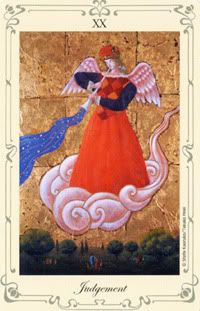
I’m used to interpreting it as a positive card, more like “breaking free”, “reaching harmony” and “getting the things you deserve”. However, having the Doomsday as the archetypal image, it is true that the meaning of the card can go both ways. So in this case, it will be more of Purgatory. And not with a road to Heaven but with a road to Hell.
First delivery from Amano Makoto, forcing Serizawa Naoto to remember the events he was so desperately trying to forget.
Once on this road, you enter a kingdom of nightmare (Moon).
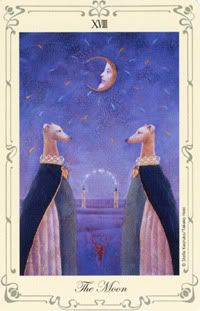
You’re between sleep and awake, not able to tell them apart. It is commotion and doubt, inability to handle your own emotions.
Naoto’s desperation on seeing people die because of him, willingness to quit the job.
There is a force of life that can lead out of darkness (Empress).

The guiding star, archetypal Heavenly Mother and Mother Nature.
The image of Shiori who only tries to see the best in people and bring out this light.
However, it can’t match the power of dark forces that keep crashing everything dear to you, all the hopes and dreams, sucking you into this dark whirlpool.
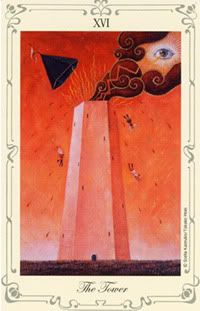
Deaths continue. The obsession with the hunt for the elusive murderer takes over.
The truth comes out, painful and bitter (Ace of Swords).

Finding out about Amano Makoto’s true identity.
And it brings about blinding wrath and aggression, like a snowball effect (Five of Wands).
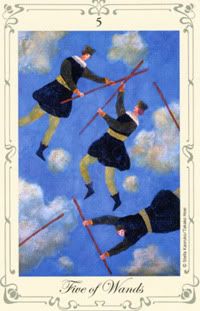
The quarrel of Souda and Kasai, murder of Souda, stabbing of Naruse-san and Kasai.
Once the Wheel of Fortune is spinning, it is almost impossible to stop it (Fortune).
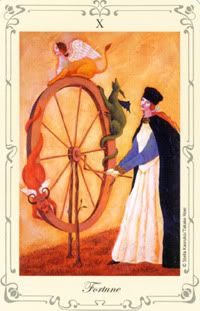
Either you fight, or you become the marionette of fate. There is no other way. But having lost yourself in the land of shadow, you do not have the power to fight, step by step you lose the true you. The only thing you see ahead is darkness.
In the end the Fate has the last word, repeating the scene that happened eleven years ago. The accidental murder as if in a mirror, the unlucky killer Naoto becoming a victim. Unlike Inanna, Manaka Tomoo and Serizawa Naoto do not survive the encounter with the shadow. To restore harmony, the Shadow takes the lives of both men, who were the reason behind so many deaths.
Last card
There was one more card in Maou, the one Shiori picked for herself before making up her mind to invite Naruse-san to a fireworks festival. It’s the Knight of Swords (King of Swords in the classical decks). One of the most beautiful cards in Stella’s deck, in my opinion. Generally, this is the image of a man of air element who is independent, strong, wise, and a bit cold. But Stella added a totally new feel to this card.
In fairy tales, it’s only Prince Charming who rides a white horse, isn’t it? And when Shiori picks the card, we do hear her friend describe Naruse-san as “ouji-sama”, Shiori’s charming prince.
A bit cold and distant, but having dreams that reach to the sky. It is the Knight of Swords in Stella’s Tarot. And for Shiori it is the image of Manaka Tomoo’s beautiful soul that she keeps in her heart even after he is gone.
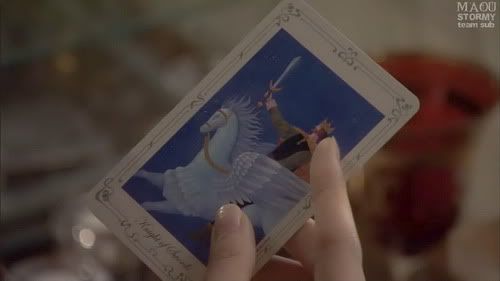

___________________________
Thank you to everybody who managed to read this long essay till the end, I hope you enjoyed it, even if just some parts.
It took me quite a while to finish but I’m really glad that I took up this challenge in the first place.
REVIEW: Maou: Encounter with the Shadow. Part 2/3
___________________________
This final research will be written through the prism of my personal experience with Tarot. Firsly, because I really wanted to include a personal touch to this part of the essay just to show why Maou’s Tarot was such a lure for me, and also to show the way I see the cards. And secondly... I just can't write it in another way, because Tarot has this very personal vibe for me.
Preface
One warm summer day 11 years ago, I was having a walk with my mum in Moscow. We were enjoying ourselves just strolling down the streets. And then at a small bookstand something caught my eye. This something eventually became one of the fields of major interest for me. It was a Tarot deck.
I don’t know why exactly I asked mum to buy the deck for me, I didn’t even know anything about divination back then. But there was something at that very moment that made me want the cards. I could never understand that sensation fully. But I never regretted getting that deck. (Especially since I was lucky enough to find a fantastic book on Tarot shortly after.)
Anyway, there I was. A 15-year-old with the classical Tarot deck, a Rider-Waite. It seemed like I got my hands on a mystery, and I felt excited. Slowly but surely I tried to learn the language of the cards, listen to the way they speak. It was quite an experience, these 11 years. I haven’t done regular daily readings, but I knew that even if I haven’t touched the cards for a year, there will come a moment when I want to take them out again.
For me Tarot is not a form of divination. It’s more like getting to know yourself in meditation, opening up and seeing the true you, knowing your strong points and weaknesses, the conscious and the subconscious.
There are dozens of ways to lay out the cards according to the question you’re asking them. I will talk about it later but… there is one spread, allegedly one of the most difficult to interpret. I only tried it once and don’t think I will be trying it for myself again without proper preparation. Ironically, this is the spread I’m going to research in this essay.
So now, without further ado, let me start on the final part of my Maou research.

III. Tarot in Maou: Inanna’s Descent and encounter with the shadow
So what is Tarot exactly?
Tarot is a deck of 78 cards used for divination (as opposed to playing cards with a set of 52). The deck is divided into two groups, Major and Minor Arcana. “Arcanum” means mystery, secret wisdom, and likewise Tarot cards reveal their mysteries to those who deal with them.
56 of Minor Arcana are related to playing cards system: they also have 4 suits (Wands, Swords, Disks/Pentacles and Cups), numbered cards from Ace to 10 and court cards (Pages, Knights, Kings and Queens). The suits also represent the four elements, four temperaments.
22 of Major Arcana alone are an incredible material for a research. Each of them possesses an archetypal image and together, from card 0 to card 21 they show “the hero’s journey”, the one you could see in myths, legends, and fairy tales. This journey is universal and can be found in myths of many different civilizations, totally unrelated to each other. It is a story of a hero guided by a heavenly force, who has many challenges on his path, the main of them being the descent into the kingdom of darkness and coming back from there to find his peace.
Back in 15th century, only the Major cards had the images on them, the Minors only depicted the number of the suit symbols (e.g. seven cups, three wands etc.). When Rider-Waite deck was created, the images were added to all the cards to help the reader interpret the meaning basing their impressions on the scenes they see on the cards.
The deck used in Maou is the incredibly beautiful Stella’s Tarot designed by famous Japanese Tarologist and astrologist, Stella Kaoruko. They have a slight difference from the classical decks but the principle is the same, 22 Major Arcana with “the hero’s journey”, and Minor Arcana.
It is true that the cards might scare you. The Major Arcana of Death, Devil and Tower are the ones that always made me feel uneasy. So when I read the cards for somebody else I always let them hold the deck and look at the images. Like any other form of knowledge, Tarot has the rules you figure out for yourself. What I understood is that you should never let the cards rule you like your life depends on what they say. It’s more like guidelines, an advice, the picture of what might happen if you don’t change your way of thinking. But you do have the power to change it all.
The Journey that gave birth to the most difficult-to-interpret Tarot spread comes from Sumer civilization. It is the story of Inanna’s descent to the underworld.
Inanna, the goddess of love and fertility in Sumer mythology, goes to visit her sister Ereshkigal, the goddess of the underworld. She wears her best festive garments and jewels displaying her power. When Inanna arrives at the gates, the gatekeeper stops her saying that she can’t enter dressed like that. The goddess then goes through seven gates of underworld leaving part of her garments and jewels behind her, thus stripping herself of her power. When she comes before the eyes of Ereshkigal, she is completely naked. Wrath and hate of the dark goddess towards her sister bring the look of death upon Inanna.
After three days and nights, Ninshubur, Inanna’s minister, follows the instructions his lady left him in case something goes wrong. He goes to three gods, Enlil, Nanna and Enki, and asks them to save Inanna. The messengers of Enki go to underworld and revive the goddess with the water of life. But nobody can escape the kingdom of darkness unless somebody takes their place. A hoard of demons surrounds Inanna: to return to the world of living she has to choose a victim that will be sent to Ereshkigal instead. She saves Ninshubur, her loyal servant, and directs the rage at her husband Dumuzi who wasn’t mourning her during these days while she was missing. Demons set Inanna free and take Dumuzi down to the pits of underworld, and thus the harmony between two worlds is restored.
The most widespread interpretations describe this myth as the biggest challenge that lies in the union with your dark side. Inanna goes to meet Ereshkigal, her “dark self”, her shadow. The encounter of the two antipodes in the kingdom of darkness causes death and destruction, it is the end of the person that Inanna once was. Reborn and returning to the “upper world”, it is the new Inanna, new identity that she takes up.
This is the concept that the Tarot spread is based on. 15 cards represent:
- Inanna, the “light” personality,
- the entrance to the underworld,
- seven life values Inanna forsakes on the way to her shadow,
- goddess Ereshkigal, the “shadow” personality,
- Ninshubur, the ally and helping force,
- food of life and water of life, two reviving forces,
- the new Inanna, new personality,
- and Dumuzi, the sacrifice to the underworld.
The reason why I never tried Inanna’s Descent in Tarot after that first time lies in the “new identity” card that I picked back then. It was The Devil. I do not remember the other cards I had in that spread but basically The Devil as the “new identity” meant that I shouldn’t provoke my dark side or search for it. Because if I do… well, the new me will not be a nice person. It might sound strange, but personal experience and that Devil card made that final click for me, making me want to write about Tarot in Maou, and the relevance of Inanna’s Descent in particular.
Manaka Tomoo is stripped of everything when he encounters his dark devilish side, of everything that was dear to him, and forsakes the last thing he has: his name, his identity, when his shadow overcomes him. The "water of life" and the image of Ninshubur in this case are both embodied in Shiori, who desperately tries to bright him out to the light again. However, there's nobody to make the sacrifice for Manaka-san, so that he can live on. To restore the harmony between the two worlds, Manaka Tomoo has to die.
I will now take the seven cards Amano Makoto used to shortly illustrate seven steps on the way to Shadow dominance, treating them as if they’re part of a Tarot spread and also adding one-line comments on correspondence of the cards to events in Maou.
In the drama Judgement was said to be “atonement for sins” which was a new meaning to me.

I’m used to interpreting it as a positive card, more like “breaking free”, “reaching harmony” and “getting the things you deserve”. However, having the Doomsday as the archetypal image, it is true that the meaning of the card can go both ways. So in this case, it will be more of Purgatory. And not with a road to Heaven but with a road to Hell.
First delivery from Amano Makoto, forcing Serizawa Naoto to remember the events he was so desperately trying to forget.
Once on this road, you enter a kingdom of nightmare (Moon).

You’re between sleep and awake, not able to tell them apart. It is commotion and doubt, inability to handle your own emotions.
Naoto’s desperation on seeing people die because of him, willingness to quit the job.
There is a force of life that can lead out of darkness (Empress).

The guiding star, archetypal Heavenly Mother and Mother Nature.
The image of Shiori who only tries to see the best in people and bring out this light.
However, it can’t match the power of dark forces that keep crashing everything dear to you, all the hopes and dreams, sucking you into this dark whirlpool.

Deaths continue. The obsession with the hunt for the elusive murderer takes over.
The truth comes out, painful and bitter (Ace of Swords).

Finding out about Amano Makoto’s true identity.
And it brings about blinding wrath and aggression, like a snowball effect (Five of Wands).

The quarrel of Souda and Kasai, murder of Souda, stabbing of Naruse-san and Kasai.
Once the Wheel of Fortune is spinning, it is almost impossible to stop it (Fortune).

Either you fight, or you become the marionette of fate. There is no other way. But having lost yourself in the land of shadow, you do not have the power to fight, step by step you lose the true you. The only thing you see ahead is darkness.
In the end the Fate has the last word, repeating the scene that happened eleven years ago. The accidental murder as if in a mirror, the unlucky killer Naoto becoming a victim. Unlike Inanna, Manaka Tomoo and Serizawa Naoto do not survive the encounter with the shadow. To restore harmony, the Shadow takes the lives of both men, who were the reason behind so many deaths.
Last card
There was one more card in Maou, the one Shiori picked for herself before making up her mind to invite Naruse-san to a fireworks festival. It’s the Knight of Swords (King of Swords in the classical decks). One of the most beautiful cards in Stella’s deck, in my opinion. Generally, this is the image of a man of air element who is independent, strong, wise, and a bit cold. But Stella added a totally new feel to this card.
In fairy tales, it’s only Prince Charming who rides a white horse, isn’t it? And when Shiori picks the card, we do hear her friend describe Naruse-san as “ouji-sama”, Shiori’s charming prince.
A bit cold and distant, but having dreams that reach to the sky. It is the Knight of Swords in Stella’s Tarot. And for Shiori it is the image of Manaka Tomoo’s beautiful soul that she keeps in her heart even after he is gone.

___________________________
Thank you to everybody who managed to read this long essay till the end, I hope you enjoyed it, even if just some parts.
It took me quite a while to finish but I’m really glad that I took up this challenge in the first place.